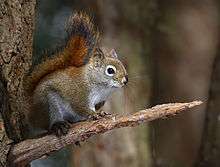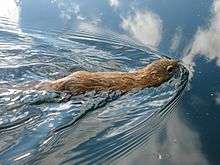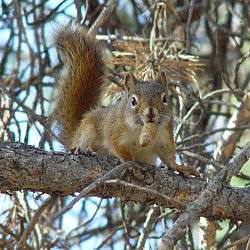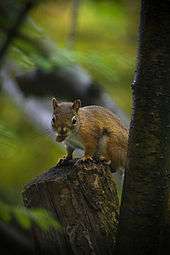American red squirrel
| American red squirrel | |
|---|---|
 | |
| An American red squirrel at Cap Tourmente National Wildlife Area, Quebec | |
| Scientific classification | |
| Kingdom: | Animalia |
| Phylum: | Chordata |
| Class: | Mammalia |
| Order: | Rodentia |
| Family: | Sciuridae |
| Genus: | Tamiasciurus |
| Species: | T. hudsonicus |
| Binomial name | |
| Tamiasciurus hudsonicus (Erxleben, 1777) | |
| Subspecies[2] | |
| |
 | |
| Distribution | |
The American red squirrel (Tamiasciurus hudsonicus) is one of three species of tree squirrel currently classified in the genus Tamiasciurus, known as the pine squirrels (the others are the Douglas squirrel, T. douglasii and Mearns's squirrel, T. mearnsi). American red squirrels are also referred to as pine squirrels, North American red squirrels, boomers,[3] and chickarees. They are medium-sized (200–250 g) diurnal mammals that defend a year-round exclusive territory. The diet of these tree squirrels is specialized on the seeds of conifer cones. As such, they are widely distributed across North America wherever conifers are common, except on the Pacific coast, where they are replaced by Douglas squirrels. Recently, American red squirrels have been expanding their range to include primarily hardwood areas.[4]
Taxonomy
American red squirrels should not be confused with Eurasian red squirrels (Sciurus vulgaris); since the ranges of these species do not overlap, they are both commonly referred to as "red squirrels" in the areas where they are native. The specific epithet hudsonicus refers to Hudson Bay, Canada, where the species was first catalogued by Erxleben in 1771.[5] A recent phylogeny suggests the squirrels as a family can be divided into five major lineages. Red squirrels (Tamiasciurus) fall within the clade that includes flying squirrels and other tree squirrels (e.g., Sciurus).[6] There are 25 recognized subspecies of red squirrels.[7]
Description
Red squirrels can be easily distinguished from other North American tree squirrels by their smaller size, territorial behavior and reddish fur with a white venter (underbelly).[7] Red squirrels are somewhat larger than chipmunks. The Douglas squirrel is morphologically similar to the American red squirrels, but has a rust-colored venter and is restricted to the southwestern coast of British Columbia and in the Pacific Northwest of the United States. These species' ranges do not overlap.
American red squirrel range

American red squirrels are widely distributed across the North American continent. Their range includes most of Canada, the southern part of Alaska, coastal British Columbia, and the Rocky Mountains and boreal forests east to the Atlantic coast.[7][8] American red squirrels are abundant and not of conservation concern throughout much of their range. However, an isolated population of red squirrels in Arizona has experienced considerable declines in population size. In 1987, this portion of the population was listed as an endangered species.[9]
Behavior
Feeding
American red squirrels are primarily granivores, but incorporate other food items into their diets opportunistically.[7] In Yukon, extensive behavioral observations suggest white spruce seeds (Picea glauca) comprise over 50% of a red squirrel's diet,[10] but squirrels have also been observed eating spruce buds and needles, mushrooms, willow (Salix sp.) leaves, poplar (Populus sp.) buds and catkins, bearberry (Arctostaphylos sp.) flowers and berries, and animal material such as bird eggs or even snowshoe hare leverets (young).[11] White spruce cones mature in late July and are harvested by red squirrels in August and September. These harvested cones are stored in a central cache and provide energy and nutrients for survival over the winter and reproduction the following spring. The fallen scales from consumed seed cones can collect in piles, called middens, more than a meter across. White spruce exhibits two- to six-year masting cycles, where a year of superabundant cone production (mast year)[12] is followed by several years in which few cones are produced.[13] American red squirrel territories may contain one or several middens.
American red squirrels eat a variety of mushroom species, including some that are deadly to humans.[14] They clip and gather truffles and other fungi and place them amongst the branches of trees to dry them in the sun.[15][16][17]
Reproduction
American red squirrels are spontaneous ovulators.[18][19] Females enter estrus for only one day, but venture from their territory prior to ovulation, and these exploratory forays may serve to advertise their upcoming estrus. On the day of estrus, females are chased by several males in an extended mating chase. Males compete with one another for the opportunity to mate with the estrous female. Estrous females will mate with 4 to 16 males. Gestation has been reported to range from 31 to 35 days.[20] Females can breed for the first time at one year of age, but some females delay breeding until two years of age or older. Most females produce one litter per year, but in some years reproduction is skipped, while in other years some females breed twice. Litter sizes typically range from one to five, but most litters contain three or four offspring. Offspring are pink and hairless at birth and weigh about 10 g. Offspring grow at approximately 1.8 g/day while nursing, and reach adult body size at 125 days. They first emerge from their natal nests at around 42 days, but continue to nurse until approximately 70 days.
Nests are most commonly constructed of grass in the branches of trees. Nests are also excavated from witches’ broom—abnormally dense vegetative growth resulting from a rust disease – or cavities in the trunks of spruce, poplar, and walnut trees. American red squirrels rarely nest below ground. Each individual squirrel has several nests within its territory, and females with young move them between nests. Some behavior has been reported within human dwellings using insulation as nesting fodder.
A three-year study of a population of red squirrels in southwest Yukon reported female red squirrels showed high levels of multiple-male mating and would even mate with males with similar genetic relatedness. While males mating with multiple females is quite common in the animal kingdom, females that mate with multiple males is rarer. When female red squirrels chose a mate, genetic relatedness did not play a factor. The relatedness of parents had no effect on the neonatal mass and growth rate of their offspring, nor did it affect the survival rate of offspring to one year of age.[21]
Dispersal and survival

Juvenile American red squirrels must acquire a territory and midden prior to their first winter to survive. They can acquire a territory by competing for a vacant territory, creating a new territory or by receiving all or part of a territory from their mothers. This somewhat rare (15% of litters) female behavior is referred to as breeding dispersal or bequeathal, and is a form of maternal investment in offspring.[22] The prevalence of this behavior is related to the abundance of food resources and the age of the mother. In some cases, females will acquire additional middens prior to reproduction, which they later bequeath to their offspring.[23] Offspring that do not receive a midden from their mother typically settle within 150 m (3 territory diameters) of their natal territory.[22]
American red squirrels experience severe early mortality (on average only 22% survive to one year of age). The survival probability, however, increases to age three, when it begins to decrease again. Females that survive to one year of age have a life expectancy of 2.3 years and a maximum lifespan of eight years.
American red squirrels are preyed upon by Canadian lynx (Lynx canadensis), bobcat (Lynx rufus), coyote (Canis latrans), great horned owl (Bubo virginianus), northern goshawk (Accipiter gentilis), red-tailed hawk (Buteo jamaicensis), American crow (Corvus brachyrynchos), American marten (Martes americana), red fox (Vulpes vulpes), gray fox (Urocyon cinereoargenteus), wolf (Canis lupus) and weasel (Mustela sp.).
Gallery
References
- ↑ Linzey, A. V. & Hammerson, G. (2008). "Tamiasciurus hudsonicus". IUCN Red List of Threatened Species. Version 2008. International Union for Conservation of Nature. Retrieved 8 January 2009.
- ↑ Thorington, R.W., Jr.; Hoffmann, R.S. (2005). "Family Sciuridae". In Wilson, D.E.; Reeder, D.M. Mammal Species of the World: a taxonomic and geographic reference (3rd ed.). The Johns Hopkins University Press. pp. 754–818. ISBN 0-8018-8221-4. OCLC 26158608.
- ↑ "Appalachian English". North Carolina Language and Life Project. 12 September 2008. Retrieved 30 May 2015.
- ↑ Goheen, J.R., R.K. Swihart, and J.H. Robins. (2003). The anatomy of a range expansion: changes in cranial morphology and rates of energy extraction for North American red squirrels from different latitudes. Oikos 102: 33-44.
- ↑ Woods, S.E.J. (1980). The Squirrels of Canada. National Museums of Canada.
- ↑ Mercer, J.\ M., and V.L. Roth. (2003). The effects of Cenozoic global change on squirrel phylogeny. Science 299:1568-1572.
- 1 2 3 4 Steele, M.A. (1998). Tamiasciurus hudsonicus. Mammalian Species 586:1-9.
- ↑ Osgood, W.H. (1900). Results of a biological reconnaissance of the Yukon River region. General account of the region. Annotated list of mammals. Annotated list of birds. North American Fauna 19:1-100.
- ↑ Arizona Game and Fish Department. (2003). Tamiasciurus hudsonicus grahamensis. Unpublished abstract compiled and edited by the Heritage Data Management System, Arizona Game and Fish Department, Phoenix, AZ. 5 pp. PDF
- ↑ McAdam & Boutin unpub. data
- ↑ Willson, Mary F.; De Santo, Toni L.; Sieving, Kathryn E. (July 2003). "Red squirrels and predation risk to bird nests in northern forests". Canadian Journal of Zoology. 81 (7): 1202–1208. doi:10.1139/z03-096.
- ↑ Kelly, D. 1994. The evolutionary ecology of mast seeding. Trends in Ecology & Evolution 9:465-470.
- ↑ Nienstaedt, Hans; Zasada, John C. (1990). "Picea glauca". In Burns, Russell M.; Honkala, Barbara H. Conifers. Silvics of North America. Washington, D.C.: United States Forest Service (USFS), United States Department of Agriculture (USDA). 1 – via Northeastern Area State and Private Forestry (www.na.fs.fed.us).
- ↑ Wernert, Susan J. (1982). Reader's Digest North American wildlife (2. pr. ed.). Pleasantville, NY [u.a.]: Reader's Digest Assoc. ISBN 0-89577-102-0.
- ↑ "The Rockies". Ray Mears' Extreme Survival.
- ↑ "Red squirrel eating a Mushroom". Retrieved 2009-02-05.
- ↑ "Mushrooms cached by a red squirrel". Retrieved 2009-02-05.
- ↑ Layne, J.N. (1954). The biology of the red squirrel Tamiasciurus hudsonicus loquax in central New York. Ecological Monographs 24:227-267.
- ↑ Millar, J.S. (1970). The breeding season and reproductive cycle of the western red squirrel. Canadian Journal of Zoology 48:471-473.
- ↑ Lair, H. (1985). Length of gestation in the red squirrel, Tamiasciurus hudsonicus. Journal of Mammalogy 66:809-810.
- ↑ Newswise: When It Comes to Female Red Squirrels, It Seems Any Male Will Do Retrieved on June 22, 2008.
- 1 2 Berteaux, D, and S. Boutin. (2000). Breeding dispersal in female North American red squirrels. Ecology 81: 1311-1326.
- ↑ Boutin, S., K.W. Larsen, and D. Berteaux. (2000). Anticipatory parental care: Acquiring resources for offspring prior to conception. Proceedings of the Royal Society of London, Series B 267: 2081-2085.
External links
| Wikimedia Commons has media related to Tamiasciurus hudsonicus. |
| Wikispecies has information related to: Tamiasciurus hudsonicus |
- Kluane Red Squirrel Project webpage – Kluane National Park and Reserve, Yukon
- Article on the American red squirrel – National Museum of Natural History
- Mount Graham Red Squirrel Research – School of Natural Resources and the Environment, University of Arizona
- American red squirrel, Fletcher Wildlife Garden

.jpg)
.jpg)
_(1).jpg)

.jpg)




